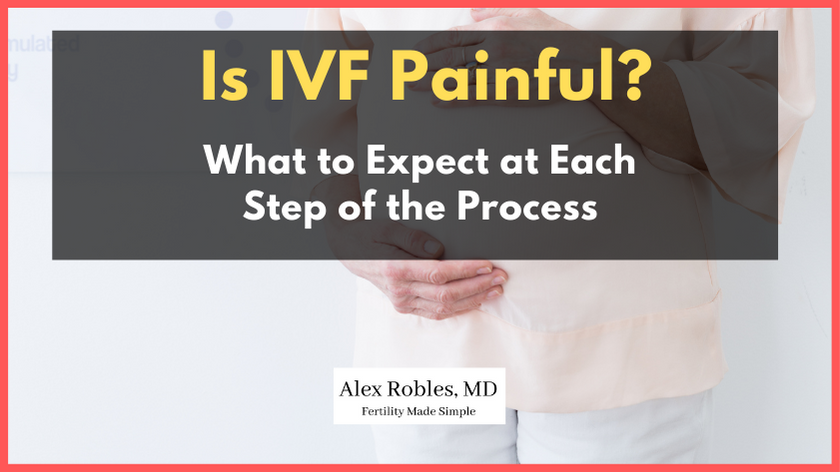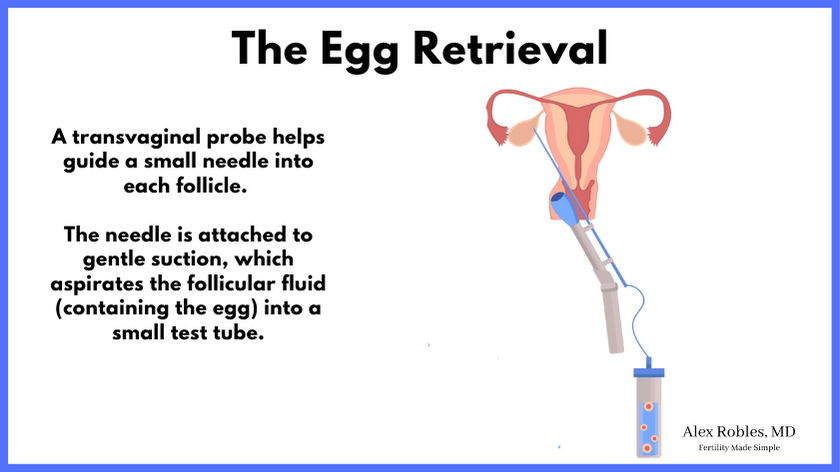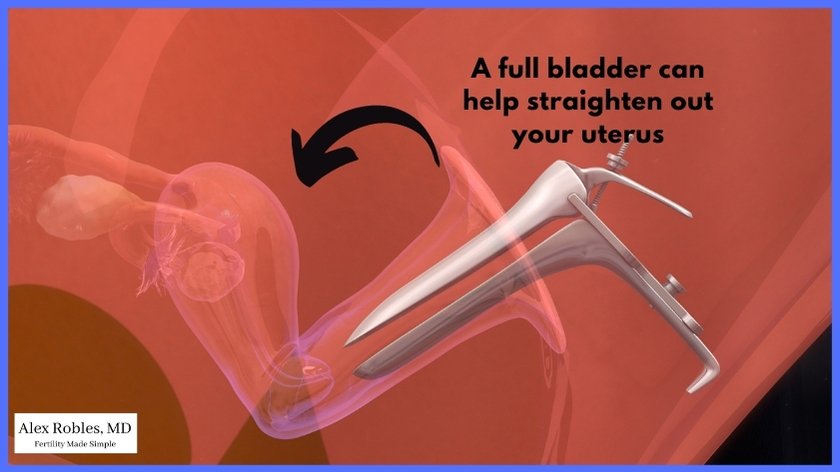Is IVF painful?
Compared to other gynecologic procedures, IVF is not very painful.
Nonetheless, different parts of an IVF cycle can cause mild to moderate discomfort.
In this article, you will learn how much pain you might expect at each step of the IVF process, from the very beginning until the pregnancy test.

What Is The Most Painful Part of IVF?
An in vitro fertilization cycle is composed of three parts:
- The ovarian stimulation
- The egg retrieval procedure
- The embryo transfer cycle
During each step, you will experience different side effects and different levels of discomfort.
On average, the egg retrieval will likely cause the most discomfort.
However, progesterone injections might be the most painful if you undergo a medicated frozen embryo transfer cycle.
Let’s go over these in more detail.
Part 1: The Ovarian Stimulation
Ovarian stimulation is the first part of an IVF cycle.
During this time, you will inject yourself with two or more subcutaneous medications every day.
This entire process can take about two weeks.
How Painful Are The Injections?
The subcutaneous IVF injections are relatively painless because the needles used are tiny.
However, despite using a thin needle, you might experience local side effects like redness, swelling, and skin irritation at the injection site.
These symptoms are more of an annoyance rather than physical pain.

How Will You Feel During The Stimulation?
The most common side effect you might experience during the stimulation phase is a bloated feeling.
This symptom is due to the growth of multiple follicles in your ovaries, which can stretch and press on surrounding tissues. The level of discomfort varies from patient to patient.
Other common side effects of IVF include:
- fatigue
- headache,
- nausea,
- mood swings,
- hot flashes,
- and cramps
Each of these is caused by the temporary elevations in estrogen hormone levels throughout the cycle.
The good news is that most of these side effects are mild and resolve quickly.
Other Things To Expect
You will need to come into the office for transvaginal ultrasounds and blood tests every 1-3 days during the initial stimulation.
The vaginal ultrasound probe and the frequent blood draws can add another layer of mild discomfort to the IVF process.
As you approach the retrieval, your visits will be more frequent.
What If You Have Sharp Pain During IVF Stimulation?
Occasional sharp pain in the pelvis can be normal. However, continuous pain that does not improve with rest can be concerning.
Call your doctor’s office if your pain is constant, worsening, or associated with nausea and vomiting.
Part 2: The Egg Retrieval Process
Once your follicles have reached a sufficient size of development, you will administer one last injection called the trigger shot.
The trigger shot (human chorionic gonadotropin) is also a subcutaneous injection.
The next step is the egg retrieval, which occurs ~36 hours after you receive the trigger.
Is The Egg Retrieval Painful?
The egg retrieval procedure can be the most uncomfortable part of an IVF cycle, but it isn’t always painful.
The procedure is done under light sedation, not general anesthesia. The latter requires you to be paralyzed and have a breathing tube.
Nevertheless, you won’t feel anything during the procedure.
The most common side effect after the retrieval is abdominal cramping, bloating, and light bleeding.
The cramping should subside within 2-3 days and respond well to over-the-counter pain medications.
If you develop ovarian hyperstimulation syndrome (OHSS), you will likely experience more intense abdominal cramping and bloating.
Unfortunately, symptoms from OHSS can last for 1-2 weeks.

What To Expect After The Retrieval
After the egg retrieval, you should not engage in strenuous activity or exercise for ~2 weeks. You should also avoid vaginal intercourse during this time.
The reason is that your ovaries are still enlarged from the stimulation. As such, any strenuous activity after the procedure can increase the risk of ovarian torsion.
Ovarian torsion presents as severe pain in the lower abdomen and is a surgical emergency.
A Quick Word On Fresh Embryo Transfer
If you are undergoing a fresh embryo transfer, the procedure will occur on Day 3 or Day 5 after the retrieval.
If you don’t have a transfer, you will get your period 10-14 days after the retrieval.
I’ll discuss what to expect at the transfer below.
Does The Menstrual Cycle After The Retrieval Hurt More Than Usual?
It is not uncommon to experience a bit more bleeding, cramping, and abdominal pain during the period following your egg retrieval.
If needed, you can take some over-the-counter pain medication as required.
Part 3: The Embryo Transfer Cycle
If you do not have a fresh transfer, you will undergo a frozen embryo transfer (FET) cycle in the future.
There are two types:
- The natural FET cycle
- The medicated FET cycle
The medicated approach requires the use of progesterone shots.
The Progesterone Shots
Progesterone injections are potentially the most painful part of the entire IVF process.
These hurt more than the stimulation medications because you need to inject the progesterone intramuscularly (IM). The needle is a little bigger and goes deeper than a subcutaneous injection.
The upper outer buttock is the most common location to inject progesterone.
After an IM injection, you can expect some pain, redness, and swelling at the injection site. You might also experience soreness in the buttocks.
Luckily, these symptoms improve over time.
Is The Embryo Transfer Painful?
The embryo transfer procedure is the least painful part of an IVF cycle.
It involves a speculum examination and the insertion of a small catheter through the cervix and into the uterus.
The discomfort you experience will likely be similar to that of a pap smear.
You might feel some mild cramping after the procedure, but this usually subsides quickly.

Does Implantation Hurt?
Another common question many patients have is if implantation causes pain.
Implantation does not hurt, but it is completely normal to have mild pelvic discomfort a couple of days after the procedure.
The reason is that implantation occurs in the first 24-48 hours after the transfer.
If you experience any discomfort during this time, it will be similar to mild period pain.
You will then check a pregnancy test ~10-14 days after the transfer.
Are Pregnancy Symptoms Worse After IVF?
Pregnancy symptoms after an IVF cycle are no different than after a natural conception.
The severity of pregnancy symptoms varies from patient to patient and isn’t related to IVF treatment.
Other Related Questions
How Many Injections Do You Need for IVF Treatment?
On average, you will need to give yourself 2-3 injections daily during the stimulation process. They are administered subcutaneously (just under the skin).
On average, you can expect the stimulation to last 8-12 days.
If you do a medicated frozen embryo transfer, you will need to give yourself an intramuscular progesterone injection daily.
The IM progesterone is done daily for several weeks until your healthcare provider tells you to stop the injections.
Should You Administer The Injections In The Stomach or Thigh?
Most patients prefer to give themselves injections in the abdomen as it is more easily accessible than the thigh.
However, either approach is equally acceptable, and you can choose the one you find most comfortable.
What About Severe Ovarian Hyperstimulation Syndrome?
Ovarian hyperstimulation syndrome (OHSS) is a condition that occurs when your body responds strongly to IVF medications.
Symptoms include:
- Abdominal pain
- Bloating (and Weight Gain)
- Nausea
- Shortness of breath
Thankfully, OHSS is usually mild and improves on its own with time.
In rare situations, you might develop severe OHSS, requiring further treatment.
Your doctor will let you know if you are at risk.
Final Words on Pain During Infertility Treatment
So is IVF painful?
Thankfully, the vast majority of patients tolerate the IVF journey well and do not find it painful.
Do not let the fear of pain prevent you from undergoing fertility treatment.
Injectable fertility medications aren’t as painful as you might expect.
The multiple daily injections are more of an annoyance than anything, but they are often necessary for your fertility journey.
While every patient will have a different experience, you can be sure to find them a tolerable part of the process.
As always, don’t hesitate to speak with your fertility clinic for more information on your specific IVF treatment.
Related Articles To The IVF Process:
- The IVF Timeline: How Long Does An IVF Cycle Take?
- The Egg Retrieval Day: How Many Eggs To Expect
- Embryo Transfer Precautions: What To Avoid After An Embryo Transfer
Make An Appointment With Dr. Robles To Discuss Your Fertility Options Today!

Alex Robles, MD
Dr. Alex Robles is a Spanish-speaking Latino-American Reproductive Endocrinologist and Infertility specialist in New York City, and a board-certified OBGYN. He has a special interest in health, lifestyle, & nutrition. Make an appointment with Dr. Robles to discuss your fertility options today!
